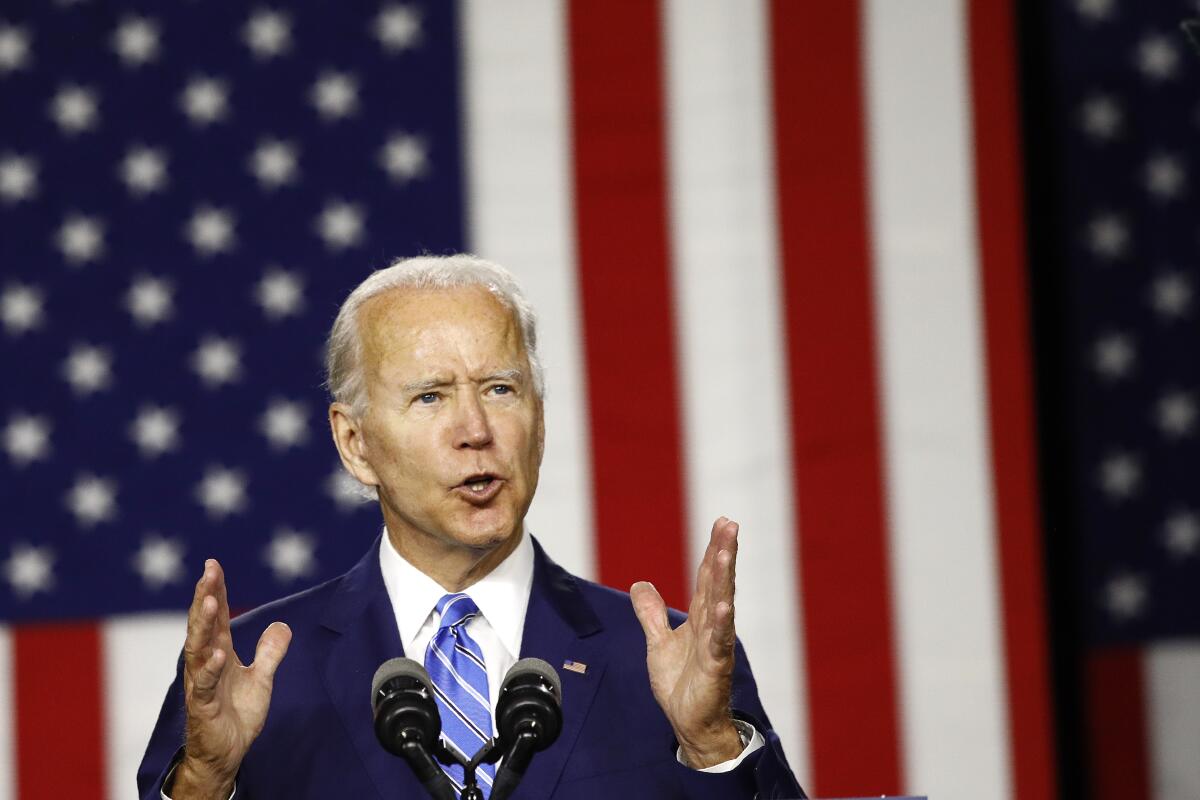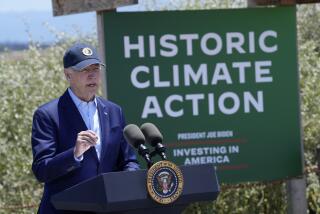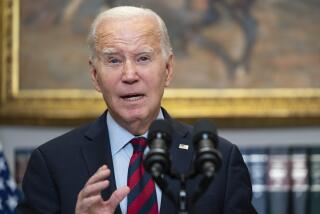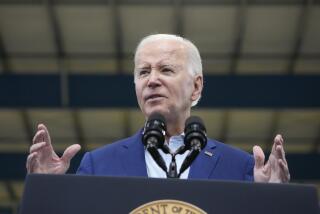Joe Biden sets out aggressive plan to tackle climate change

- Share via
WASHINGTON — Joe Biden unveiled a proposal for rebuilding the economy Tuesday that focuses heavily on restoring American leadership in the fight against global warming, directing government recovery efforts toward expanding clean energy and rapidly reversing the Trump administration’s abandonment of climate efforts.
In a speech in Wilmington, Del., the former vice president called for a massive green jobs and environmental justice program that would invest $2 trillion in his first term on building new renewable energy infrastructure.
“Climate change is a challenge that’s going to define our American future,” Biden said. “I know meeting the challenge will be a once in a lifetime opportunity to jolt new life into our economy, strengthen our global leadership, protect our planet ... We’re not just going to tinker around the edges. We’re going to make historic investments that will seize the opportunity to meet this moment in history.”
The spending would go toward expansion of high-speed rail, building electric cars and greatly increasing the use of wind, solar and other renewable technologies to generate power, among other goals. Under Biden’s plan, the U.S. would fully end the use of oil, coal and other fossil fuels to generate electricity by 2035. He would bring the nation to net zero emissions of greenhouse gases no later than 2050.
The plan is notably more aggressive than the one Biden campaigned on during his party’s primaries, part of an overall move in which he has embraced some of the proposals of his more progressive rivals in an effort to unify the party for the general election.
Nominees typically moderate their positions as they move into the general election. On climate, Biden is going in the opposite direction.
Compared with Biden’s earlier proposals, the current one would spend more, do it faster and aim more investment toward disadvantaged communities.
“The science tells us there is no time for delay on climate change,” the plan says. “Biden will make a $2 trillion accelerated investment, with a plan to deploy those resources over his first term, setting us on an irreversible course to meet the ambitious climate progress that science demands.”
Biden stressed the need to put policies in place that could not be unwound the way President Trump has tried to reverse the Obama administration’s climate plans.
“We’re going to lock in progress that no future president can roll back or undercut to take us backward again,” he said.
Republicans warned the plan would further sink the economy and trigger the loss of millions more jobs.
“Today, Joe Biden gave a speech in which he said the core of his economic agenda is a hard-left crusade against American energy,” President Trump said during an hourlong Rose Garden polemic against Biden. “He wants to kill American energy. This would do nothing for the environment but would cripple the American economy.”
Biden’s increased assertiveness on climate comes as the former vice president has worked to build bridges with the progressive wing of the Democratic Party in the face of a pandemic that has left millions of Americans unemployed. The proposal is part of a broader economic plan Biden began unveiling last week, aimed at creating the largest public investment in American infrastructure since World War II.
Some key details, however, were absent from the proposal. Most notably, it does not specify how it would be paid for. Senior campaign officials said a rollback of the Trump tax cuts, as well an increase in corporate taxes would be part of the payment plan, which the campaign vowed to release in the coming months.
Biden has also said he supports a carbon tax — a policy many environmental economists say is crucial to effectively curbing climate change — but there is no mention of that in the current proposal.
Much of the plan would require congressional approval, which would prove a heavy lift even if Democrats win back control of the Senate.
Even so, the audacity of the spending plan reflects the increased appetite among voters for taking action to curb global warming, as scientists warn time is running short and Trump administration rollbacks have left America isolated from the global effort.
“When Donald Trump thinks about climate change, the only word he can muster is ‘hoax,’” Biden said. “The word I think of is ‘jobs.’”
Get our L.A. Times Politics newsletter
The latest news, analysis and insights from our politics team.
You may occasionally receive promotional content from the Los Angeles Times.
The plan would quickly inject $400 billion into the federal purchase of clean energy technologies with the goal of accelerating research development “on a scale well beyond the Apollo program.”
It aims to create 1 million new auto industry jobs by pushing the industry — which has been resistant to change — to take the lead in electric-vehicle manufacturing. High-speed rail is a focal point of the plan, as is a big investment in zero-emission public transit.
The goal for quickly decarbonizing the power sector would require new subsidies such as tax credits and grants to accelerate production of solar and wind energy technologies.
The federal government would also help subsidize the retrofitting of 4 million buildings to make them more energy efficient and aim to create 250,000 jobs “plugging abandoned oil and natural gas wells and reclaiming abandoned coal, hardrock, and uranium mines.”
Much of the money would be aimed at disadvantaged communities.
“We have to make sure that the first people who benefit from this are the people who were most hurt historically,“ Biden said.
His plan sets a goal that low-income communities that have traditionally suffered disproportionately from pollution would receive 40% of “overall benefits of spending” by the federal government in areas such as clean energy and energy efficiency, green transportation and sustainable housing.
Underpinning the plan is a restructuring of key agencies in the federal government, restoring the climate-forward focus put in place by the Obama administration but then abandoned by Trump.
The Justice Department, for example, would launch a new Environmental and Climate Justice Division “to hold polluters accountable.”
“We’re going to hold accountable those CEOs of corporations that benefit from decades of subsidies that just walked away from their responsibilities to these communities, leaving the wells to leak,” Biden said.
Such an agency was championed by Gov. Jay Inslee of Washington, an early rival of Biden’s in the presidential primary who ran on a platform dominated by confronting climate change. Biden adopted several of the ideas pushed by Inslee in his plan.
The plan also reflects parts of the agenda of another erstwhile rival, Sen. Bernie Sanders of Vermont, whose supporters agreed to work with the former vice president on policy compromises that would help unify the Democratic Party.
But some goals of progressives are notably absent from the plan. It does not include a ban on fracking, which many on the left are demanding but which some Biden advisors consider politically untenable in key states such as Pennsylvania. The plan also embraces nuclear energy as a viable zero-emission technology, even as many environmentalists are demanding closure of America’s remaining nuclear plants.
The target of achieving “net zero emissions” by 2050 may also underwhelm activists who say such action is too little, too late. Polluters arguably could continue to emit large amounts of greenhouse gases even after the goal is reached by offsetting them with such activities as planting trees.
Sanders had demanded a far more rigid rule on curbing emissions, calling for “complete decarbonization” by 2050.
More to Read
Get the L.A. Times Politics newsletter
Deeply reported insights into legislation, politics and policy from Sacramento, Washington and beyond. In your inbox three times per week.
You may occasionally receive promotional content from the Los Angeles Times.











